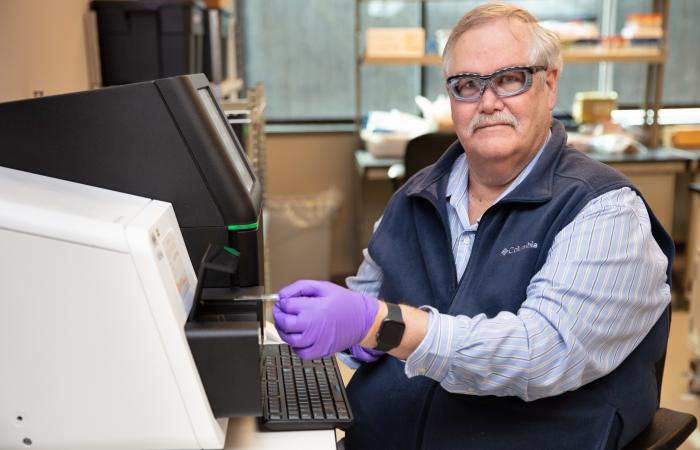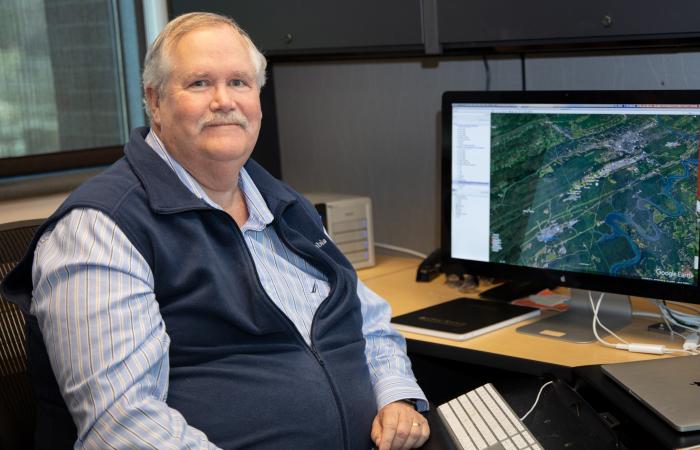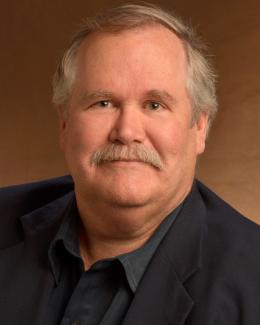In the course of a career spent studying ecosystems affected by industrial processes, Terry Hazen’s work has pivoted from what microorganisms can do to you, to what they can do for you. Today, his work largely focuses on how naturally occurring bacteria can break down and detoxify hazardous materials, including the remediation of industrial waste in bodies of water.
Hazen, the Tennessee Governor’s Chair for Environmental Biotechnology in the Biosciences Division at Oak Ridge National Laboratory, began his career studying fish and alligator diseases at the Savannah River nuclear reservation. “We were trying to figure out why so many alligators were dying at the site,” Hazen said.
He was a doctoral candidate in microbial ecology at Wake Forest University at the time. Hazen and his colleagues determined that the deaths were likely due to a common bacterium found in alligators, Aeromonas hydrophila, that reached toxic levels when the animals were subject to stressors such as trapping, handling, and warmer than normal water temperatures.
The experience was an entry to U.S. Department of Energy bioremediation research that would lead Hazen to multiple DOE sites over the years as he researched microorganisms.
Perhaps the most well known example is the finding by Hazen that naturally occurring microbes in the Gulf of Mexico’s depths actively assisted in degrading the oil plume from the Deepwater Horizon well blowout, as detailed in the journal Science. More recently he has been leading a team of researchers testing the effects of biocides present in hydraulic fracking fluids on stream health in Pennsylvania.
Hazen has also applied his genomics expertise to an analysis of the impacts of phosphorus levels on microbial functions in tropical soils, including how these microbial communities can predict climate feedbacks, in a lab-directed research program. He has explored microbes that can help break down biomass for bioenergy production. And he has studied the use of bacteria as biosensors: leveraging DNA analysis of microbial communities to identify environmental contaminants.
Along the way, Hazen has supervised nearly 45 graduate student theses, mentored more than 200 undergraduate students, authored more than 369 scientific publications, earned two R&D 100 awards, and is a fellow of the American Academy of Microbiology and the American Association for the Advancement of Science. He was also awarded the DOE BER Distinguished Scientist Award, one of only four ever given. He is director of the Field Microbiology Scientific Focus Area for ENIGMA (Ecosystem and Networks Integrated with Genes and Molecular Assemblies), a DOE consortium that seeks to advance microbial biology and the impact of microbial communities on their ecosystems, served as director of the Institute for Secure and Sustainable Environments at the University of Tennessee, and now is director of the Methane Center at UT.
Childhood explorations stoke an interest in environmental science
Growing up, Hazen spent his summers on the shores of Lake Michigan where his family owned a cabin 40 miles from the nearest town. “From an early age I was out exploring, hunting and fishing. I was always interested in nature,” which led to an interest in environmental science in school, he noted.
He earned a bachelor’s and master’s degrees in interdepartmental biology from Michigan State University. Soon after, he was offered a technician position at the University of Georgia’s ecology lab, researching environmental impacts at the Savannah River site.
That experience led to an offer to study fish diseases at Wake Forest in conjunction with a former professor. So Hazen and his wife stayed in the south, where he earned a PhD in microbial ecology at Wake Forest while working for DOE and state organizations interested in environmental remediation.
Hazen’s career then took a turn toward the tropics. He applied for and was offered a teaching position at the University of Puerto Rico just after his father-in-law, who lived on the island, suffered a heart attack and needed help with rehabilitation. In his eight years in Puerto Rico, Hazen moved up from assistant to associate professor and eventually to chair of the Biology Department and director of graduate studies. Some of his fondest teaching memories were in the tropical rainforests and coral reefs of the island, and his children were born there.
The Hazens moved back to the U.S. mainland in 1987 where Terry once again worked at Savannah River; his bioremediation research there lasted 11 years. He moved to the Lawrence Berkeley National Laboratory in 1998, where he was able to expand the scope of his research while serving as environmental remediation lead. During that time he co-founded the precursor to the ENIGMA program—Ecosystems and Networks Integrated with Genes and Molecular Assemblies—and became involved in the lab-industry research partnership known as the Energy Biosciences Institute, which led him to the Deepwater Horizon project.
There is always science of opportunity. Be aware of it and be flexible.
The science of opportunity
Hazen made the move to Tennessee in 2011 to assume the UT-ORNL Governor’s Chair position. The Governor’s Chairs program provides joint appointments at the University of Tennessee, Knoxville, and ORNL for some of the nation’s top scientists, transforming such fields as energy production, environmental systems, manufacturing and materials science, and computing technologies. Hazen already had significant experience working with ORNL scientists on various remediation projects as part of his DOE-sponsored research.
Looking forward, Hazen hopes to expand his work in the oil and gas sector to improve hydraulic fracturing. “Fracking has enabled the recovery of vast amounts of oil and natural gas, and made us energy independent. But we can handle the associated water issues a lot better than we are now,” he said. “Treating frack water will require an approach that takes into account everything from the ecosystem down to the molecular level.”
He also sees great promise in methane hydrates. These crystalline structures occur naturally on the sea floor and contain super concentrations of methane. “Methane hydrates contain more energy than anything else, but we still don’t know much about them,” Hazen said. “We need to invest in developing ways to efficiently harvest that methane from hydrates.”
Following on his similar role in the ENIGMA consortium, Hazen will also engage in research on the nitrogen cycle as part of ORNL’s Genes to Ecosystems initiative, which seeks to better understand the link between genes, traits, and large, complex networks to better manage ecosystems. He encourages colleagues to “engage in a systems approach in your work,” knowing that future science challenges will require large, multidisciplinary teams.
Hazen also characterizes the projects he’s been involved in as taking advantage of the “science of opportunity,” which he highly recommends to young researchers. It’s a philosophy of ensuring you’re aware of trends and issues that your area of science can be applied to, and then being proactive in seeking out those new opportunities, he says.
“There is always science of opportunity. Be aware of it and be flexible,” Hazen said.
ORNL is managed by UT-Battelle for the Department of Energy's Office of Science, the single largest supporter of basic research in the physical sciences in the United States. DOE’s Office of Science is working to address some of the most pressing challenges of our time. For more information, please visit https://energy.gov/science.




